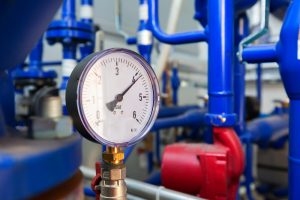
Pneumatic flow aids use pressurized air to stimulate material flow. Fluidizers and air pads use a combination of aeration and gentle vibration and are typically used for fine powders. However, low-pressure air can’t activate heavy materials or break bridging, arching, and ratholing.
AirSweep releases high-pressure air pulses and is proven effective for problematic materials. One unit can activate more material than dozens of fluidizers, and flush the vessel completely clean.
The AirSweep system just needs to be hooked up to a good air supply that provides enough pressure and volume to power up each pulse. Here are some frequently asked questions about AirSweep and the cost and efficiency of using pressurized air to solve material blocks.
Why do I need high-pressure air to solve material blocks?
Bridging, arching, and ratholing are caused either by a material’s high cohesive strength, or particles that interlock and are then further packed together by downward pressure.
The high-pressure air pulses create a shockwave that breaks up the material blocks and sweep up the stalled material out of the vessel. This can’t be achieved by gentle aeration.
How does AirSweep compare to air cannons and air knockers?
Air cannons and air knockers also use high-pressure air in higher volumes. However, these require more plant air and energy, and the strong recoil can cause metal fatigue.
Furthermore, using bigger blasts of air doesn’t necessarily improve material flow. The peak force lasts only 1/1000th of a second – subsequent discharge is wasted energy. The air also tends to “channel” through holes in the material, greatly diminishing effectiveness.
AirSweep releases short, controlled pulses exactly where and when you need it, so you never use more plant air or energy than you have to. You can control the position of each nozzle, the duration between each pulse, and the sequence. You can also choose between the classic AirSweep which releases pulses in 360 degrees or the Straight Shooter model which releases a vertical column of air.
What kind of plant air can be used?
The AirSweep can pass any inert medium that can be pressurized. Some plants have even used nitrogen with AirSweep to help purge oxygen from the vessel to reduce explosion or fire hazards.
Is it expensive to use high-pressure compressed air?
AirSweep is very cost-efficient. Unlike fluidizers and air pads which run continuously, the nozzles release air pulses in sequence. So even if you have several units on a vessel, they only pulse one at a time. AirSweep also uses less plant air and electricity than air cannons and air knockers.
Can damp air damage the AirSweep?
Damp air will not damage the unit itself, but it can introduce moisture into the material and cause it to cake or gum up. That is why we recommend treating the air before it goes into the system.
Can AirSweep cause air pressure build-up?
Pressure build-up is not an issue because the AirSweep system is not run until the vessel is actively discharging.
The AirSweep design also allows you to customize the flow. For example, if the material has a tendency to overflow, air pressure can be lowered to lessen the volume or area of influence, or the pulse frequency and sequence can be changed. You can also get a smaller AirSweep unit with a smaller sweep diameter.
Will the air pulses cause segregation and demixing?
As long as the AirSweep is tied into the discharge cycle, there will be no segregation. In fact, AirSweep is often used to maintain blend uniformity.
An infant formula company uses AirSweep at the start of the packaging lines—where base powders with vitamins and other compounds are mixed—down to their receiving hoppers and sifters. The air pulses ensure continuous material flow, so the product remains consistent from start to finish.
Can AirSweep units on different vessels share systems like an air receiver?
If two vessels are used simultaneously, it depends on whether the compressed air supply can handle the load. If these are used simultaneously and are in close proximity, then they can be connected to the same air receiver, filter, and regulator.
Do you have questions about AirSweep and pneumatic flow aids that weren’t covered by this article? Contact us and we’ll be happy to give you information or customize a proposal.





Comments are closed